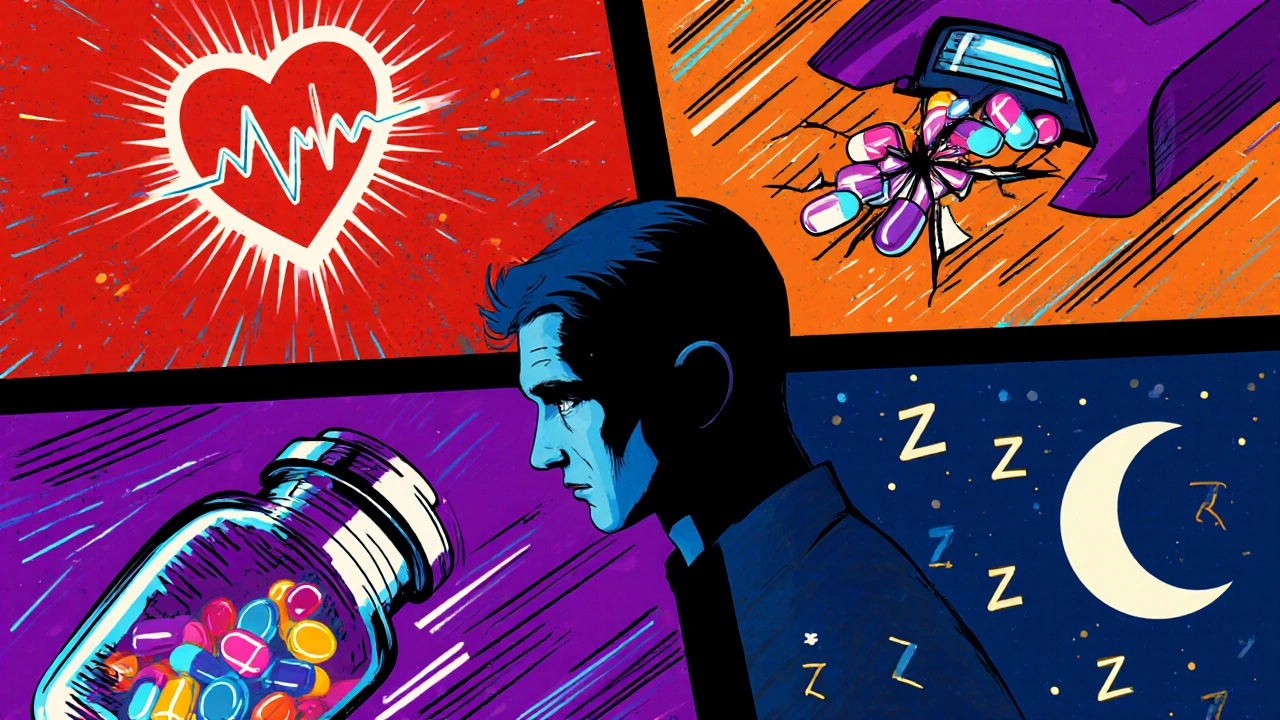
ADHD Life Expectancy Risk Calculator
Personal Health Assessment
Based on the latest research, adults with ADHD have a 46% higher risk of all-cause mortality. This tool estimates how your current health habits affect your risk compared to the general population.
Key Takeaways
- ADHD is linked to a 2‑3 year reduction in average lifespan.
- Higher death rates stem from cardiovascular disease, accidents, substance misuse and chronic sleep problems.
- Effective treatment, lifestyle changes and regular health monitoring can narrow the lifespan gap.
- Early screening for comorbid conditions is essential for preventing premature death.
- Living with ADHD doesn’t guarantee a shorter life - proactive management makes a huge difference.
When you hear that ADHD lower life expectancy is a real concern, the first reaction is often shock. Why would a condition best known for attention challenges affect how long you live? The answer lies in a web of medical, behavioral and social factors that stack up over years. Below we break down the main reasons, look at the numbers, and share practical steps anyone can take to protect health.
ADHD is a neurodevelopmental disorder characterized by inattention, hyperactivity, and impulsivity. It affects roughly 9% of children and about 4‑5% of adults worldwide. While many people associate ADHD with school difficulties, the condition’s impact stretches far beyond the classroom and into long‑term physical health.
How Much Does ADHD Shorten Life Expectancy?
Large‑scale epidemiological studies from Scandinavia, the United States and the United Kingdom consistently show that adults with ADHD die about 2-3years earlier than their peers without the diagnosis. A 2022 meta‑analysis of nine cohort studies reported a pooled hazard ratio of 1.46 for all‑cause mortality, meaning a 46% higher risk of dying at any given age.
1. Cardiovascular Disease - The Silent Threat
Cardiovascular disease includes heart attacks, strokes and hypertension is the single biggest driver of early death in the ADHD population. Impulsivity and chronic stress raise blood pressure, while untreated ADHD often leads to poor diet, irregular exercise and smoking - all classic heart‑risk factors.
Research from the Danish National Patient Registry (2021) found that adults with ADHD were 1.3 times more likely to develop hypertension and 1.5 times more likely to suffer a heart attack before age50 compared with matched controls.
2. Accidents and Unintentional Injuries
Impulsivity and a tendency to seek novel stimulation translate into higher rates of traffic crashes, falls, and workplace injuries. A 2020 U.S. study of motor‑vehicle records showed that drivers with ADHD were 1.8 times more likely to be involved in a serious collision.
Because many injuries happen at a young age, they contribute heavily to the overall mortality gap, especially when fatal head injuries or severe trauma occur.
3. Substance Abuse and Overdose
People with ADHD are up to three times more likely to develop substance‑use disorders. The self‑medication hypothesis suggests that individuals may turn to alcohol, nicotine, or illicit drugs to calm racing thoughts. Unfortunately, this raises the risk of overdose, liver disease and infectious complications.
Data from the National Survey on Drug Use and Health (2023) indicated that 32% of adults with ADHD reported past‑year illicit drug use, compared with 13% of the general adult population.

4. Sleep Disorders - The Hidden Mortality Driver
Sleep disorder encompasses insomnia, restless‑leg syndrome and circadian‑rhythm disturbances is common in ADHD, affecting up to 60% of patients. Chronic sleep deprivation triggers inflammation, impairs glucose regulation and increases the likelihood of heart disease.
A 2021 longitudinal study linked severe insomnia in ADHD adults to a 28% rise in all‑cause mortality over a ten‑year follow‑up.
5. Metabolic Issues and Obesity
Impulsive eating and irregular meal patterns often lead to weight gain. Obesity itself is an independent risk factor for heart disease, diabetes and certain cancers.
Among adolescents with ADHD, 38% were classified as obese, compared with 22% of their non‑ADHD peers (CDC, 2022).
6. Comorbid Mental Health Conditions
Depression, anxiety and bipolar disorder frequently coexist with ADHD. These conditions can worsen medication adherence, increase suicide risk, and amplify physical health problems.
Suicide rates are roughly twice as high in adults with ADHD, according to a 2020 systematic review of 12 international cohorts.
7. Medication Effects and Healthcare Gaps
Stimulant medication such as methylphenidate and amphetamines, is the first‑line treatment for ADHD improves focus and reduces impulsivity, which can lower accident risk. However, side effects like increased heart rate and blood pressure mean that regular cardiovascular monitoring is crucial.
Unfortunately, many adults with ADHD discontinue medication after adolescence, often due to stigma or limited access to specialty care, leaving them exposed to the health risks outlined above.
Putting the Numbers in Perspective - A Comparison Table
| Risk Factor | ADHD (% of deaths) | General Population (% of deaths) | Relative Increase |
|---|---|---|---|
| Cardiovascular disease | 27% | 19% | +42% |
| Accidents & injuries | 15% | 9% | +67% |
| Substance‑related deaths | 12% | 5% | +140% |
| Suicide | 9% | 4% | +125% |
| Other (cancers, infections) | 37% | 63% | -41% |

Actionable Strategies to Close the Gap
Knowing the risks is only half the battle. Here are evidence‑based steps you can take, whether you’ve been diagnosed with ADHD or are supporting someone who has.
- Regular medical check‑ups: Schedule annual blood pressure, cholesterol and glucose screenings. If you’re on stimulant meds, ask your doctor to monitor heart rate.
- Adhere to medication when prescribed. Side‑effects can often be managed by adjusting dosage or switching to a non‑stimulant like atomoxetine.
- Prioritize sleep: Aim for 7-9hours, keep a consistent bedtime, and limit screen exposure an hour before sleep. Cognitive‑behavioral therapy for insomnia (CBT‑I) works well for ADHD patients.
- Stay active: Even brief, frequent movement (e.g., walking, cycling) reduces cardiovascular risk and helps regulate mood.
- Mindful eating: Use planners or apps to avoid impulsive snacking, focus on whole foods, and watch portion sizes.
- Risk‑aware driving: Consider defensive‑driving courses, avoid high‑risk situations (nighttime, heavy traffic) when impulsivity is high.
- Substance‑use screening: Be honest with your healthcare provider; early intervention programs can prevent escalation.
- Therapy and coaching: Behavioral therapy, ADHD coaching, or CBT can improve organization, reduce stress, and lower the chance of accidents.
When to Seek Professional Help
If you notice any of the following, it’s time to contact a clinician:
- Persistent chest pain, shortness of breath, or palpitations.
- Sudden changes in mood, increased suicidal thoughts, or hopelessness.
- Unexplained weight gain or loss of more than 5% of body weight in a month.
- Frequent accidents, injuries, or traffic violations.
- Difficulty sleeping more than three nights per week.
Early detection of these warning signs can dramatically improve outcomes and add healthy years to your life.
Future Directions - What Research Is Showing
New longitudinal studies are exploring whether early, sustained treatment can completely erase the mortality gap. Preliminary data from a 2024 French cohort suggests that adults who begin stimulant therapy before age12 and maintain adherence reduce their cardiovascular risk to near‑population levels.
Genetic research is also uncovering links between ADHD‑related dopamine pathways and inflammation, hinting at novel therapeutic targets that could impact long‑term health.
Bottom Line
ADHD does lower life expectancy, but the reasons are largely preventable: heart disease, accidents, substance misuse, sleep problems and related mental‑health issues. By staying vigilant about medical monitoring, maintaining a healthy lifestyle, and seeking consistent treatment, you can shrink-or even eliminate-the lifespan difference.
Frequently Asked Questions
How much shorter is the lifespan for someone with ADHD?
On average, adults with ADHD die about 2-3years earlier than peers without the condition. The exact gap varies with lifestyle, treatment adherence and presence of comorbidities.
Does medication increase the risk of early death?
Stimulant medication can raise heart rate and blood pressure, but when monitored properly it usually reduces risk by improving focus and lowering impulsivity. The net effect is generally protective, not harmful.
Can lifestyle changes offset the mortality risk?
Yes. Regular exercise, balanced nutrition, adequate sleep, and avoidance of tobacco or excessive alcohol can bring the risk of heart disease, obesity and accidents down to levels similar to the general population.
Why are accidents more common in people with ADHD?
Impulsivity leads to quicker, less‑thoughtful decision‑making, especially in high‑speed environments like driving. Inattention can also cause missed cues, increasing the chance of collisions or falls.
Is the increased suicide risk linked only to depression?
Depression is a major factor, but the constant frustration, social stigma and impulsive behavior associated with ADHD also raise suicide risk. Early mental‑health support is vital.
How often should I get cardiovascular check‑ups if I have ADHD?
At a minimum, an annual physical that includes blood pressure, cholesterol and resting heart‑rate measurements is recommended. If you’re on stimulants, your doctor might suggest more frequent monitoring, especially during the first year of treatment.
Can ADHD be diagnosed in older adults?
Yes. Many adults are diagnosed later in life after realizing lifelong patterns of inattention and impulsivity. Proper diagnosis can open the door to treatment that may improve both mental and physical health outcomes.





Rohan Talvani
I am a manufacturing expert with over 15 years of experience in streamlining production processes and enhancing operational efficiency. My work often takes me into the technical nitty-gritty of production, but I have a keen interest in writing about medicine in India—an intersection of tradition and modern practices that captivates me. I strive to incorporate innovative approaches in everything I do, whether in my professional role or as an author. My passion for writing about health topics stems from a strong belief in knowledge sharing and its potential to bring about positive changes.
view all postsWrite a comment